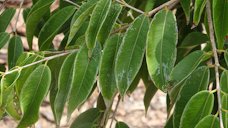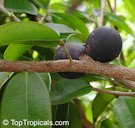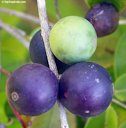| Blue Grape - Myrciaria vexator | |||||||
|---|---|---|---|---|---|---|---|
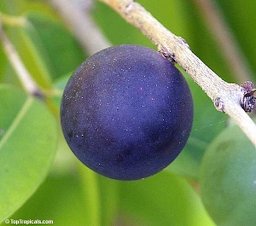 Fig. 1 Myrciaria vexator, blue jaboticaba, blue grape, false jaboticaba 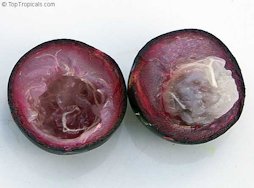 Fig. 2  Opened fruit 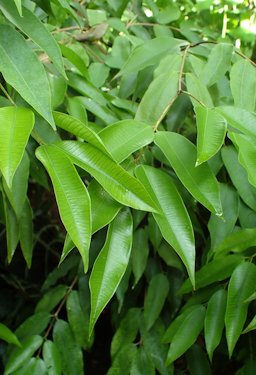 Fig. 3  Leaves 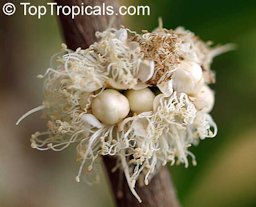 Fig. 5  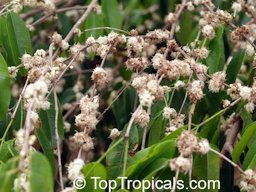 Fig. 6  Inflorescense 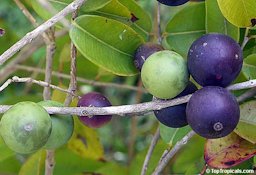 Fig. 7  Fruit habit 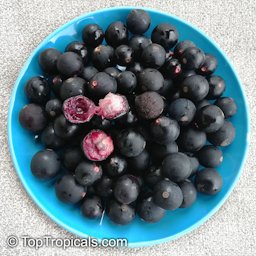 Fig. 10  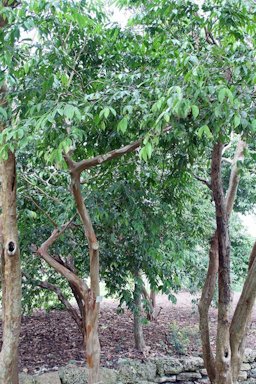 Fig. 11  Plant growing in the Fairchild Tropical Botanic Garden, Miami, Fl USA 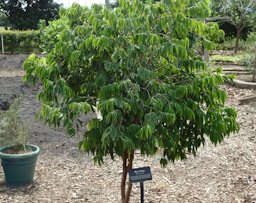 Fig. 12  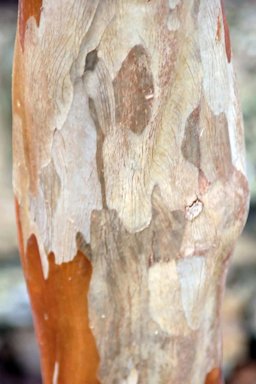 Fig. 13  The attractive bark |
Scientific
name Myrciaria vexator McVaugh Common names Blue grape, blue jaboticaba, False jabuticaba; Apanish: guaperu, guapuru, hivapuru, sabará, and ybapuru Synonym No known synonym Relatives Jaboticaba, Myrciaria cauliflora Berg.; camu-camu, M. dubia; false tamarisk, M. borinquena; rumberry, M. floribunda; ridfetop guavaberry, M. myrtiflolia 1 Family Myrtaceae (myrtle family) Origin From Costa Rica and Panama to Venezuela 2 USDA hardiness zones 10a, 10b, 11 Uses Fruit; landscape specimen Height 10-15 ft (3-4.6 m) 2 Crown Rounded canopy that extends almost to the ground; dense; finely textured 1 Plant habit Small tree or bush Growth rate Slow-growing evergreen tree 2 Trunk/bark/branches Multiple trunks, light gray; peeling bark; heavily branched beginning close to the ground 1 Leaves Bright green; glossy; opposite, entire, oblong-lanceolate; 3-5 in. (7.6-12.7 cm) 1 Flowers Small, white; appear on both older branches and new growth 1 Fruit Berry; thick skin, inedible; pulp sweet and mildly aromatic; 1-1.5 in. (2.5-3.8 cm) 1 Season Main crop matures in the spring 1 Light requirement Full sun Soil tolerances Will grow on a varity of soils, including oolitic limestone and clay 1 Drought tolerance Appears to have greater tolerance than it's cousin the jaboticaba 1 Cold tolerance Hardy to 28-32°F (°C) Invasive potential * None reported Pest/disease resistance Relativerly free of pests and diseases in Florida 1 Known hazard None Reading Material Blue Grape, Fruitipedia, Encyclopedia of the Edible Fruits of the World Origin South America, from Costa Rica and Panama to Venezuela. Description The blue grape is an exquisite landscape specimen that bears a delicious grapelike fruit. The species is obscure and only available from specialized sources. Some consider the fruit slightly inferior to that of the jaboticaba, although it is of very good quality and pleasant flavor. As a result of its many attributes, the blue grape has excellent potential as a dooryard tree for south Florida. 1 The bark, which is decorated with a reticulated patten, occasionnaly peels in large patches (Fig. 11), revealing a light undercoat. The tree is handsome, ornamental, and well behaved, and would be worth planting for its aesthetic value alone. 1 Leaves The bright green leaves, are opposite, entire, oblong-lanceolate, and pointed at the apex. They are glossy, slightly folded along the central axis, and point stffly downward. 1
Flowers Flowering occurs in 2 or 3 waves, often in late winter of early spring. The small white flowers appear both on older branches and on new growth. It is thought that cross-pollination is needed to ensure adequate fruit set. 1 Fruit The fruit of the blue grape is a thick-skinned berry, measuring from 1 to 1 1/2 inches in diameter. The skin changes from bright green to a dull bluish-purple as the fruit ripens. The rind is tough, rubbery and inedible. The pulp is gelatinous and somewhat translucent. The color of the pulp is whited tinged with pink or orange. The flavor is sweet and mildly aromatic. 1
Fig. 8. Fruit grows directly on the branch Fig. 9. Immature and ripe fruit Harvesting The blue grape is harvested when fully colored and slightly soft to the touch. The main crop matures in the spring, although fruit may be present throughout the warmer months. 1 Propagation By seed. Seeds are slow to germinate, sometimes requiring 3 or more months to sprout. 1 Irrigation It requires regular irrigation during establishment, but appears to have greater drought tolerance than the jaboticaba. 1 Pests/Diseses The blue grape is relatively free of pests and diseases in Florida. The skin of the fruit is sufficiently tough to resist attack by the Caribbean fruit fly. 1 Food Uses The fruit is usually eaten out of hand, with the pulp sucked from the rind. The rind and seeds are discarded. The fruit spoils and dehydrates rapidly once it has been picked. 1 List of Growers and Vendors |
||||||
| Bibliography 1 Boning, Charles. Florida's Best Fruiting Plants: Native and Exotic Trees, Shrubs and Vines. Sarasota, Florida: Pineapple Press, 2006. 2 Barwick, Margaret. Tropical & Subtropical Trees. A Worldwide Encyclopaedic Guide. London, 2004. Photographs Fig. 1,2,5,6,7,8,9,10 "Myrciaria vexator." Top Tropicals, toptropicals.com. Accessed 28 Jan. 2015. Fig. 3 Kenraiz, Krzysztof Ziarnek. "Myrciaria vexator in Boltz Conservatory, Madison, Wi." Wikimedia Commons, 2016, (CC BY-SA 4.0), commons.wikimedia.org. Accessed 27 Mar. 2017. Fig. 4,12 Sample, Jane. "Myrciaria vexator." Flickr, 2015, flickr.com. Accessed 27 Mar. 2017. Fig. 11 Stang, David. "Plant growing in the Fairchild Tropical Botanic Garden, Miami, Fl, USA." Useful Tropical Plant Database, (CC BY-NC-SA 3.0), tropical.theferns.info. Accessed 27 Jan. 2015. Fig. 13 Stang, David. "The attractive bark." Useful Tropical Plant Database, (CC BY-NC-SA 3.0), tropical.theferns.info. Accessed 27 Jan. 2015. * UF/IFAS Assessment of Non-native Plants in Florida's Natural Areas ** Information provided is not intended to be used as a guide for treatment of medical conditions. Published 27 Jan. 2015 LR. Last update 7 Apr. 2023 LR |
|||||||
